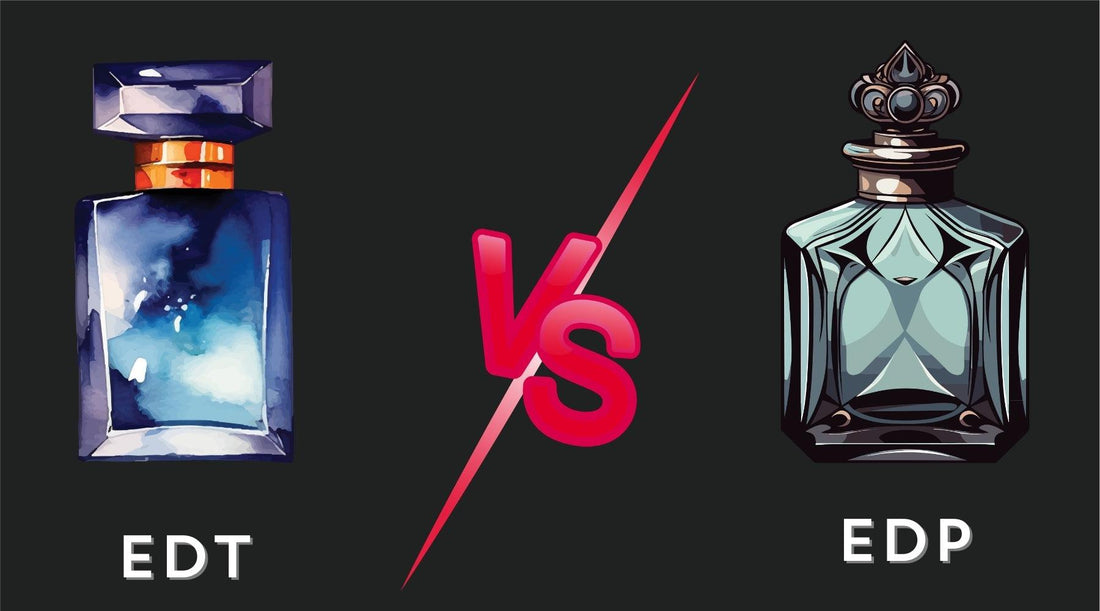
EDT vs. EDP: What’s the Difference
Fragrance lovers often find themselves at a crossroads when choosing between Eau de Toilette (EDT) and Eau de Parfum (EDP). While both belong to the same family of perfumery, their unique characteristics and uses set them apart. In this guide, we’ll explore the nuances of EDT and EDP, covering everything from their compositions to popular brands that offer these beloved scents.
Understanding EDT (Eau de Toilette)
What is Eau de Toilette?
Eau de Toilette is a lighter, more refreshing fragrance often associated with daytime wear. Originating from the French term "faire sa toilette," meaning grooming, EDT was historically used as a scented water for refreshing oneself.
Concentration Levels
Eau de Toilette typically contains 5–15% fragrance oils diluted in alcohol and water. Its lower concentration results in a lighter scent that lasts between 3 to 5 hours.
Popular EDT Fragrances
Some iconic EDTs include:
- Dior Sauvage EDT: A fresh, spicy fragrance perfect for men who want an energetic yet sophisticated aura.
- Chanel Chance Eau Tendre: A floral and fruity EDT that exudes a delicate charm, ideal for women during springtime.
- Versace Pour Homme EDT: A citrusy, aromatic scent that works well in professional settings.

Understanding EDP (Eau de Parfum)
What is Eau de Parfum?
Eau de Parfum is more intense and long-lasting than EDT. With origins in luxury perfumery, EDP caters to those who prefer a stronger, more defined fragrance.
Concentration Levels
EDPs contain 15–20% fragrance oils, offering better longevity, often lasting 6 to 8 hours. Their richer, more pronounced scent makes them ideal for evening or special occasions.
Popular EDP Fragrances
Renowned EDPs include:
- Yves Saint Laurent Black Opium: A seductive coffee and vanilla-based scent beloved for nighttime wear.
- Creed Aventus EDP: A luxurious and bold scent for men, combining pineapple, birch, and musk.
- Jo Malone Peony & Blush Suede EDP: A floral masterpiece that’s feminine and elegant.
Key Differences Between EDT and EDP
Fragrance Concentration
EDTs are lighter with less fragrance oil, while EDPs offer a richer concentration. This difference directly affects their scent intensity and how long they linger.
Longevity and Performance
If you prefer a subtle scent that won’t overpower a room, EDT is a better option. For lasting impressions, especially at events, EDP’s longevity makes it the clear winner.
Sillage and Projection
EDPs generally project more strongly and leave a more prominent scent trail, known as sillage. EDTs, by contrast, tend to stay closer to the skin.
Factors to Consider When Choosing EDT or EDP
Personal Preferences
Your choice often boils down to personal taste. Do you enjoy a light, refreshing fragrance or a bold, long-lasting scent?
Skin Chemistry
Fragrances react differently depending on your skin type. Oily skin tends to hold scent longer, which can make EDT a practical option, while dry skin may benefit from the lasting power of EDP.
Climate and Occasion
In warmer weather, EDT’s lighter composition feels more comfortable. EDP, with its richness, suits cooler climates and formal occasions.
Cost Differences Between EDT and EDP
Because EDPs contain more concentrated fragrance oils, they tend to be more expensive than EDTs. For instance:
- Dolce & Gabbana Light Blue EDT (50ml): Approximately $80.
- Dolce & Gabbana Light Blue EDP (50ml): Around $120.
While the price difference is notable, the longevity and intensity of EDP often justify the cost.
Popular EDTs and EDPs in the Market
Top EDT Recommendations
- Burberry Brit EDT: Perfect for casual outings with its fresh and spicy notes.
- Hermès Terre d’Hermès EDT: Earthy and citrusy, ideal for professional men.
- Marc Jacobs Daisy EDT: A youthful floral fragrance for women.
Top EDP Recommendations
- Tom Ford Tobacco Vanille EDP: A warm, spicy fragrance perfect for winter nights.
- Lancôme La Vie Est Belle EDP: Sweet and elegant, capturing joy in a bottle.
- Bleu de Chanel EDP: A sophisticated, versatile scent for men.
How to Layer EDT and EDP
Combining Fragrances
For a unique scent, try layering EDT and EDP from the same fragrance line. Start with the lighter EDT as a base and finish with EDP for added depth.
Avoiding Overload
Apply sparingly when layering to avoid overwhelming the senses.

FAQs About EDT and EDP
What is the main difference between EDT and EDP?
EDT has a lighter concentration of fragrance oils (5–15%) compared to EDP’s richer formula (15–20%). This affects longevity and intensity.
Which lasts longer, EDT or EDP?
EDPs generally last longer, often up to 8 hours, while EDTs typically last 3–5 hours.
Are EDTs cheaper than EDPs?
Yes, EDTs are generally more affordable due to their lower concentration of fragrance oils.
Can I wear EDP during the day?
Absolutely! However, opt for lighter EDPs with subtle projection to avoid overwhelming those around you.
Are there unisex EDTs and EDPs?
Many brands, such as Le Labo and Byredo, offer unisex fragrances in both EDT and EDP formulations.
How can I choose between EDT and EDP?
Consider your lifestyle, preferred scent intensity, and when you plan to wear the fragrance.
Conclusion
Both EDT and EDP have their own charm, catering to different preferences and occasions. While EDT offers a light, refreshing experience for daily wear, EDP provides a bold, long-lasting scent that shines during special moments. By understanding their differences and considering your personal needs, you can confidently select the fragrance that complements your unique style.
